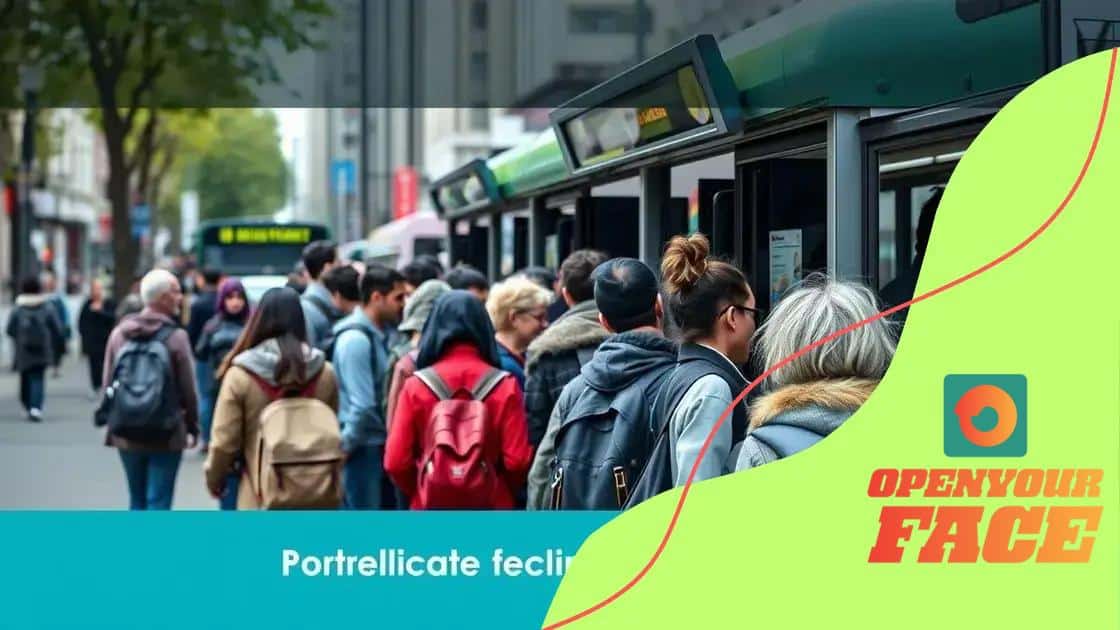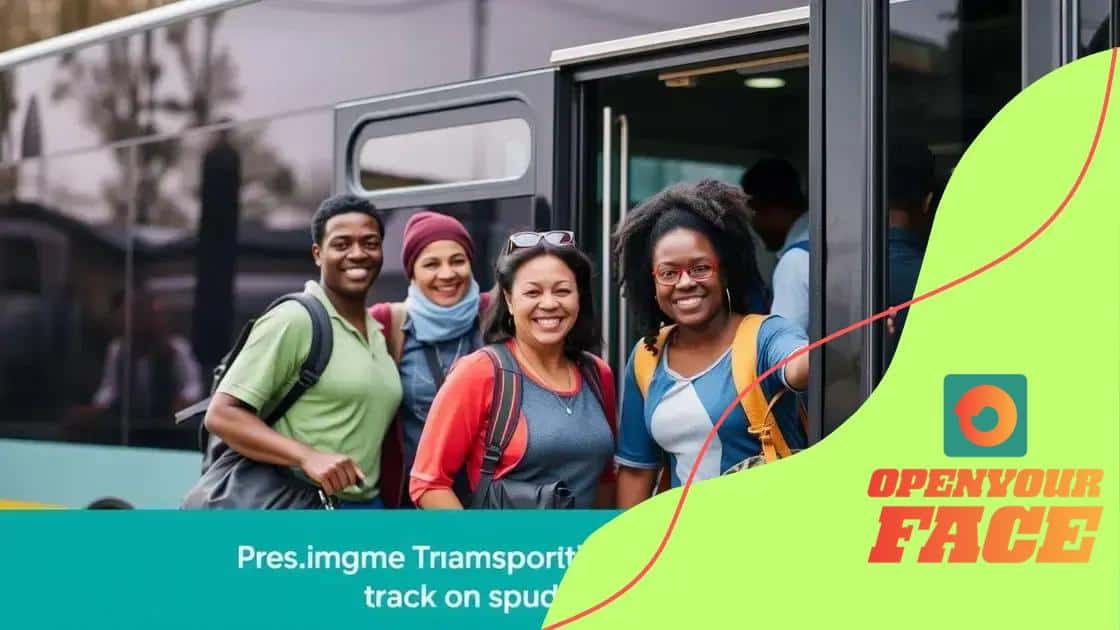Public transportation subsidies for low-income workers

Public transportation subsidies for low-income workers significantly enhance access to jobs by reducing travel costs, thereby promoting employment opportunities and improving overall quality of life.
Public transportation subsidies for low-income workers play a crucial role in enhancing their mobility and access to employment opportunities. Have you ever thought about how they could change lives for the better? In this article, let’s dive into the significance of these subsidies, the impact they can make, and the challenges we need to address.
Understanding public transportation subsidies
Understanding public transportation subsidies is essential for recognizing how they can aid low-income workers. These subsidies are financial assistance programs provided by governments to make public transportation more affordable.
They ensure that those who earn less can still access necessary services, such as jobs and education. By reducing travel costs, these programs encourage more people to use public transport, which can lead to less traffic congestion and a cleaner environment.
Types of Subsidies
There are various types of public transportation subsidies available.
- Direct fare discounts: Lowered ticket prices for eligible individuals.
- Free transit passes: Offered to low-income workers to remove any fare barriers.
- Employer-sponsored subsidies: Companies may subsidize transportation costs for their employees.
Each program comes with its own requirements, often requiring applicants to provide proof of income. Understanding these programs can help individuals take advantage of available resources.
The Impact on Communities
These subsidies can significantly impact communities. They enhance mobility by allowing low-income workers to reach jobs that might have otherwise been inaccessible due to high travel costs.
Moreover, public transportation subsidies promote social inclusion. They enable individuals to participate fully in their communities. From attending job interviews to accessing healthcare, these subsidies can play a critical role in improving quality of life.
Furthermore, as more people use public transport, communities experience reduced pollution levels and increased public safety. The reduction in cars on the road can lead to fewer accidents, benefitting everyone.
In conclusion, understanding the workings and benefits of public transportation subsidies can empower low-income workers. By making public transit more affordable, these programs promote greater participation in the workforce and overall community engagement.
Importance of subsidies for low-income workers
The importance of subsidies for low-income workers cannot be overstated. These financial aids help to create a level playing field, allowing individuals with limited means to access essential services. By reducing transportation costs, these subsidies make it easier for low-income workers to reach their jobs and support their families.
Having affordable public transportation opens up opportunities for education and career advancement. Many workers might feel stuck without reliable transit options, but subsidies can significantly change this. They not only alleviate financial burdens but also promote a sense of independence and empowerment.
Benefits of Transportation Subsidies
Transportation subsidies bring numerous benefits that extend beyond individual workers.
- Increased employment: Subsidies make it easier for workers to get to their jobs, potentially leading to higher employment rates.
- Economic growth: More accessible transportation can stimulate local economies as workers have better access to jobs and businesses.
- Improved quality of life: Subsidies help low-income individuals connect with essential services, such as healthcare and education, improving overall well-being.
Moreover, when people can reach their jobs without worrying about transportation costs, they are more likely to remain in stable employment. This continuity is vital for both the workers and the economy. As families thrive, communities are strengthened. This creates a cycle of improved living standards and opportunities.
Low-income workers often face multiple barriers, and eliminating one of those through subsidies can lead to positive ripple effects. Access to reliable transportation enhances not only job opportunities but also social interactions and community engagement. For many, these subsidies serve as a lifeline, helping them to not just survive, but thrive.
How subsidies can improve access to jobs

Subsidies play a crucial role in improving access to jobs for low-income workers. By making public transportation more affordable, these financial aids help people reach their workplaces without the burden of high travel costs. When transportation is accessible, finding and maintaining a job becomes much easier for those who struggle financially.
Many individuals miss job opportunities simply because they can’t afford daily commute expenses. Transportation subsidies break down these barriers and create paths to employment that were once out of reach. This access allows workers to explore a wider range of job options, rather than being limited to positions near their homes.
Impact of Improved Accessibility
Improved access to transportation leads to several benefits for workers and communities.
- Job retention: When workers can reliably get to their jobs, they are less likely to miss shifts and are more likely to stay employed.
- Increased job applications: With reduced commuting costs, individuals are more willing to apply for positions that may be farther from home.
- Higher wages: Access to more job opportunities often leads to better-paying positions, contributing to overall economic improvement.
Furthermore, when people can easily commute to work, it fosters a sense of stability in their lives. This stability extends to their families and communities, creating a more thriving and engaged populace. Workers who feel secure in their jobs are often more productive and invested in their work, leading to better outcomes for employers as well.
In addition, by enabling more people to access jobs, transportation subsidies contribute to diversity in the workplace. Employers gain a broader pool of candidates, allowing them to hire from a richer variety of backgrounds and experiences. This diversity can drive innovation and better service as different perspectives come together.
Real-world examples of successful subsidy programs
Real-world examples of successful subsidy programs showcase how effective these initiatives can be in enhancing transportation access for low-income workers. These programs have been implemented in various cities, demonstrating various strategies that make public transport more affordable.
Programs like the MTA’s Fair Fares in New York City offer half-price MetroCard fares for low-income residents. This initiative significantly eases the financial burden on individuals who rely on public transportation for commuting to work. Similarly, cities like San Francisco have introduced Clipper START, which provides discounted fares to qualifying low-income adults, allowing many to access employment opportunities that were previously financially out of reach.
More Examples of Successful Programs
Several other cities have also rolled out successful subsidy programs. These include:
- Los Angeles County’s Access Services: Offers specialized transportation services at reduced rates for eligible individuals, ensuring that those with disabilities can get to work.
- Chicago’s Ride Chicago: Provides discounts for low-income residents on public transit to promote job access and participation in community activities.
- Seattle’s ORCA LIFT: This program provides a reduced fare card for low-income individuals, making it easier for them to commute for work and other essential activities.
These examples illustrate that when local governments provide targeted support, they can significantly improve the lives of low-income residents. By investing in transit subsidies, cities not only help individuals but also foster stronger, more resilient communities. Furthermore, these successful programs demonstrate that effective public transportation policy can lead to broader social benefits, creating jobs and stimulating local economies.
When such programs are thoughtfully designed and effectively communicated, they can result in a win-win situation. Communities thrive when their members have the ability to travel safely and affordably to work.
Potential challenges and solutions for implementing subsidies
Implementing subsidies for public transportation can face several challenges. Recognizing these hurdles is crucial for creating effective programs that benefit low-income workers. One common issue is funding. Many municipalities struggle to allocate sufficient financial resources to support these initiatives.
In addition, there can be resistance from certain stakeholders, including taxpayers who may be concerned about where their money is going. Ensuring transparency and demonstrating the long-term benefits of subsidies are essential to gain public support. When people understand how these programs lead to job creation and community growth, they are more likely to be in favor of them.
Challenges to Consider
Here are some potential challenges that might arise during the implementation of subsidy programs:
- Administrative complexity: Managing subsidy programs can be complicated, requiring tracking and oversight to ensure proper distribution.
- Eligibility determination: Establishing clear and fair criteria for who qualifies can be difficult and may inadvertently exclude deserving individuals.
- Public awareness: Many eligible individuals may not know about available subsidy programs, leading to low enrollment and underutilization.
Despite these challenges, there are solutions. One approach is to streamline the application process. By making it easy and accessible, more low-income workers will benefit. Using technology, such as online platforms, can help reduce administrative burdens while improving outreach.
Additionally, conducting community outreach and education campaigns can raise awareness about the available subsidies. Partnering with local organizations can help target those most in need, ensuring that the information reaches the right audience.
Another solution involves collaborating with stakeholders to develop a sustainable funding model. Promote the long-term economic benefits of public transportation subsidies to garner broader support, emphasizing how improved access to jobs can enhance overall community well-being.
Implementing public transportation subsidies can make a significant difference for low-income workers. While there are challenges like funding and public awareness, successful programs have shown that these hurdles can be overcome. Clear communication and community outreach are essential for helping those in need. By investing in these subsidies, communities can create better job access, improve quality of life, and drive economic growth. Ultimately, the goal is to ensure that everyone has the opportunity to thrive and succeed, regardless of their financial situation.
FAQ – Frequently Asked Questions about Public Transportation Subsidies
What are public transportation subsidies?
Public transportation subsidies are financial aids provided by the government to reduce transportation costs for low-income workers, helping them access jobs and essential services.
How do transportation subsidies benefit low-income workers?
They make it more affordable for low-income workers to commute, thus improving their job access, employment rates, and overall quality of life.
What challenges are faced in implementing subsidies?
Challenges include securing funding, ensuring public awareness, and managing the administrative processes involved in distributing the subsidies.
How can communities support transportation subsidy programs?
Communities can support these programs by advocating for funding, raising awareness about available subsidies, and collaborating with local organizations to ensure that eligible individuals are informed.






